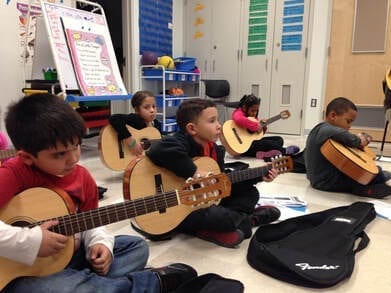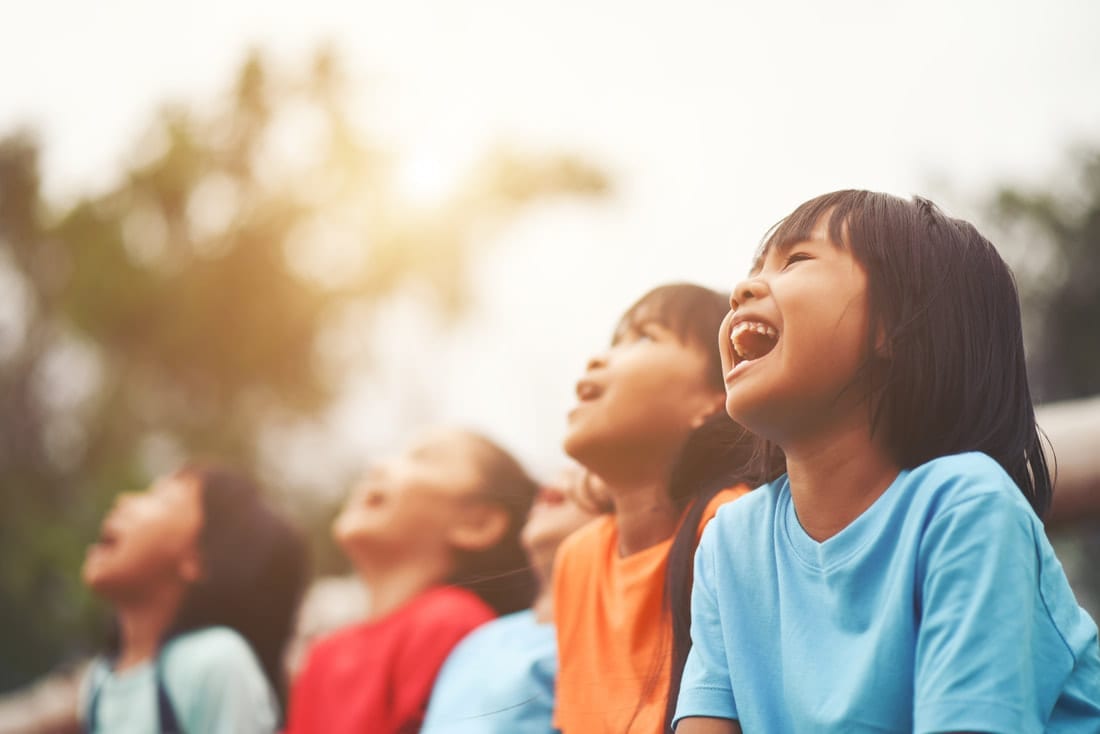Almost everyone has experienced, at one point or another, the powerful influence of music – from feeling compelled to move our feet and dance when we hear a certain beat to feeling strong emotions when we listen to our favorite sad song. It’s no surprise, then, that music can be one of the most impactful and effective methods of therapy. Music-based interventions work because, simply put, music is like food for our brains.
 Believe it or not, this isn’t just a cliché. Science has shown that music can be physically and biologically powerful, and musical behaviors of all kinds (playing and/or listening) can have lasting effects on our brain function. Studies have shown that music-based therapies are extremely effective in children with Autism Spectrum Disorders (ASDs) and other developmental disorders, as well as typically developing children. But what makes music so impactful for children with ASDs in particular?
Believe it or not, this isn’t just a cliché. Science has shown that music can be physically and biologically powerful, and musical behaviors of all kinds (playing and/or listening) can have lasting effects on our brain function. Studies have shown that music-based therapies are extremely effective in children with Autism Spectrum Disorders (ASDs) and other developmental disorders, as well as typically developing children. But what makes music so impactful for children with ASDs in particular?
The Development of Language and Communication
Musical experiences, like singing or playing musical instruments, clearly require both non-verbal and verbal communication between individuals. When the members of a choir sing together, they read each other’s gestures and body movements to stay together. When an orchestra performs, violin players make eye contact with viola and cello players, doing all but speaking out loud to communicate across the stage.
Music itself is actually very closely related to language. Both music and language are made up of complex acoustic information, and they require the use of attention and memory processes to understand. They both have a “hierarchical arrangement,” where the musical notes or keys that make up a song are equivalent to the letters or words that make up a sentence. This means that when a child with ASD learns musical skills, there is also an easy transfer of knowledge to language development.
 Active music therapies, involving either singing or music-making on an instrument, lead to significant improvements in verbal communication skills, in addition to non-verbal and gestural communication skills, in autistic children. Musical training can also improve other skills of perception. This makes sense, because musicians have to be able to perceive even small changes in pitch, tempo (speed), and rhythm. Musical activities help children with ASDs with music and speech perception, but also with their expression of language. When children are able to take part in musical activities, they outperform other children on verbal memory, verbal fluency, and non-verbal reasoning tasks
Active music therapies, involving either singing or music-making on an instrument, lead to significant improvements in verbal communication skills, in addition to non-verbal and gestural communication skills, in autistic children. Musical training can also improve other skills of perception. This makes sense, because musicians have to be able to perceive even small changes in pitch, tempo (speed), and rhythm. Musical activities help children with ASDs with music and speech perception, but also with their expression of language. When children are able to take part in musical activities, they outperform other children on verbal memory, verbal fluency, and non-verbal reasoning tasks
Social/Emotional Development and Behavioral Skills
Making music in a group setting is one of the best opportunities to develop social connections with others. Making music in a group creates a shared purpose and a sense of togetherness in a way that other, non-musical group activities do not. It also provides an opportunity to learn social skills like imitation, social reciprocity, shared affect, and empathy, all skills that are often impaired in individuals with ASDs.
Even when we are listening to music, we can discern a variety of different emotions, like happiness, sadness, fear, or anger. A more upbeat song might communicate happiness to the listener, while a slower melody is sad. Making music is similar – when children with ASDs make music or sing, they convey the same range of emotions and foster empathy with their musical partners.
Social skills beyond emotional communication are also enhanced through music-based therapies. Eye contact, general engagement with others, and spontaneous initiation of social interactions can all be increased for children with ASDs through musical therapy. After interacting with others in musical ways, children are more likely to help others and cooperate with their partners in general, even when those cooperative interactions are not musical in nature.
Gross and Fine Motor Skills
Children with autism often have significant impairments in fine motor skills (like small movements in the fingers) or gross motor skills (like overall balance and coordination). All of these issues can easily be addressed using musical activities that are targeted towards practicing certain motor skills. Using the whole body in musical, rhythmic actions can provide great opportunities to enhance gross motor skills. Clapping along or walking to the beat of the music are two examples of synchronizing the body in this way, promoting motor coordination in children.
 Fine motor skills can be targeted through various musical instruments, such as the piano or the guitar. As children with ASDs practice these instruments, they refine and coordinate tiny movements of the fingers and hands, addressing the fine motor delays we often see in those with autism.
Fine motor skills can be targeted through various musical instruments, such as the piano or the guitar. As children with ASDs practice these instruments, they refine and coordinate tiny movements of the fingers and hands, addressing the fine motor delays we often see in those with autism.
Music’s Physical Effect on the Brain
Beyond behavioral changes, musical activities can also have a major impact on the physiology of the brain! Musical activities increase something called “brain plasticity,” in all people, not just those with ASDs. Brain plasticity, or neuroplasticity, is a term that refers to how the brain changes and adapts as a result of our everyday experiences. This type of flexibility is critical because it allows our brains to develop as we grow older, creating new connections between brain cells when we learn new activities or skills. When children receive musical training, even over the short course of a year, their brains undergo massive change, in the areas of the brain involved in the cortical motor system, the auditory system, and more. Major findings in the cognitive neurosciences have found that musical practice is generally associated with large increases in our structural and functional brain plasticity.

Music’s Physical Effect on the Brain

Music is an especially great way to engage with autistic children because musical activities are not intimidating. Children with ASDs, who normally have difficulties directly engaging with others can more easily initiate interactions when there is a common goal of making music together. A child with autism can also spontaneously explore various ways of making music – trying out different instruments or singing until they find their favorite activity.
However, generally, there is a more universal reason why children with ASDs tend to gravitate towards music and musical behaviors – it’s fun! Whether it’s listening to music or making music with others, music can be a very fun and rewarding experience for all involved. Children with ASDs, in particular, find musical activities enjoyable, perhaps because they have an enhanced musical understanding.
Music is an effective way to communicate with, engage, and reach children with autism. It can improve general communication skills, language development, social and emotional development, and gross and fine motor skills. It can physically cause long-lasting changes to the brain. And most importantly, it can be fun – like another form of play, something ASD children can engage in without feeling like it’s too much work.
Check out some of these research papers and other sources about the impact of music on the brain and children with ASD!
- Music, biological evolution, and the brain (Patel A.D., 2010): [http://hdl.handle.net/10427/009075]
- Rhythm, movement, and autism: using rhythmic rehabilitation research as a model for autism (Hardy M.W. and LaGasse A.B., 2013): [https://www.frontiersin.org/articles/10.3389/fnint.2013.00019/full]
- Language, music, syntax and the brain (Patel A.D., 2003): [https://www.ncbi.nlm.nih.gov/pubmed/12830158]
- The Effect of Music vs. Nonmusic Paired with Gestures on Spontaneous Verbal and Nonverbal Communication Skill of Children with Autism between the Ages 1-5 (Farmer K.J., 2003 [http://diginole.lib.fsu.edu/islandora/object/fsu%3A182621]
- Music therapy for autism spectrum disorder (Gold C., Wigram T. and Elefant C., 2006): [https://www.ncbi.nlm.nih.gov/pubmed/16625601]
- Practicing a musical instrument in childhood is associated with enhanced verbal ability and nonverbal reasoning (Forgeard M., 2008): [https://www.ncbi.nlm.nih.gov/pubmed/18958177]
- Social connection through joint action and interpersonal coordination (Marsh K.L., Richardson M., and Schmidt R.C., 2009): [https://www.ncbi.nlm.nih.gov/pubmed/25164936]
- Being together in time: musical experience and the mirror neuron system (Overy K. and Molnar-Szakacs I., 2009[https://www.research.ed.ac.uk/portal/files/11822810/Being_Together_in_Time_Musical_Experience_and_the_Mirror_Neuron_System.pdf]
- Effectiveness of Music Therapy Interventions on Joint Attention in Children Diagnosed with Autism: A Pilot Study(ReitmanM.R.,2005[https://books.google.com/books/about/Effectiveness_of_Music_Therapy_Intervent.html?id=HgKWNwAACAAJ]
- Using embedded music therapy interventions to support outdoor play of young children with autism in an inclusive community-based child care program (Kern P. and Aldridge D., 2006): [https://www.ncbi.nlm.nih.gov/pubmed/17348756]
- Music drives brain plasticity (Jäncke L., 2009): [https://www.ncbi.nlm.nih.gov/pmc/articles/PMC2948283/]




0 Comments